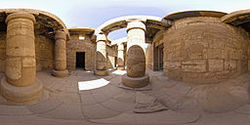 The temple Karnak is 300 miles distance from Cairo. Picture source: Wikimedia by By Focusredsea
The temple Karnak is 300 miles distance from Cairo. Picture source: Wikimedia by By Focusredsea The document containing the itinerary is several pages long and is dated 1869 with a ? in brackets. Dr. Durant, William’s father, bankrolled two of his son's expeditions to Egypt, one in 1869 and one in 1873. William also went back on his yacht in 1892. It is unclear when this event actually took place.
However it is easy to understand where William got his flair for entertaining; he took cues from his father. It was a Durant trait to spend lavishly on entertainment. While President of the Union Pacific Railroad in 1866, Dr. Durant executed an extravagant event, ushering investors and politicians from the east coast to the middle of the western wilderness. There they encamped and witnessed a spectacle of mock Indian warfare (including a reenactment of an Indian raid on the railroad).
Like his father, William knew how to put on a show. William had an interior room of Karnak decorated in the style of an ancient Arabian apartment, with imported carpets, wall hangings and palms. He had the temple lit up with colored fires and the entrance illuminated with 100 colored lanterns. He brought in fine china and linen. Arabian music and dancers entertained the guests during the supper with a fireworks display after the meal.
He ordered twenty fowl, four turkeys, four tongues, 20 loaves of bread, and a sheep. The guests were not short of libations. For the European guests, William had on hand twenty-four bottles each of champagne, claret and sherry. He had three dozen bottles of lemonade and coffee for the Arab guests. He made sure tobacco, cigars, and pipes were on hand.
He must have spent days planning it because each page lists details written with military precision. He hired the Sheik’s guards and gave them instructions on where they had to be and when and who to admit to the feast (Europeans were to be admitted instantly, no questions asked). He had each action timed so that the servants knew when to serve the coffee to the Arab guests, when to light the colored fires, etc. The cost must have been astronomical.
The evening’s itinerary is laid out on page one:
- Illumination of the temple with lanterns – 8 p.m.
- Supper in the temple – 9 p.m.
- Arab music and dancing
- Fireworks 10 p.m.
- Illumination of the temple with colored fires
Also included in the list were items that needed to be ordered from Cairo: 3-4 iron mortars for the rockets; 200 rockets; 100 paper lanterns, 50 colored glass lanterns. The list of fire-related illumination goes on for two pages. The light show would have rivaled a present-day rock concert. And although our modern sensibilities may not comprehend why anyone would be allowed to access an ancient temple in Egypt to show off their wealth, the opening of the Suez Canal in 1869 brought an influx of British and French business interests. Perhaps the Sheik was also trying to impress? By 1892, British was considered a 'Protectorate' over Egypt, there would have been many expats living there at the time William was visiting on his yacht.
William's penchant for entertaining was a theme throughout his life. When he moved to America in 1874 and took over building the family estate in the Adirondack Wilderness, he entertained at his Great Camps. Diaries of people that attended these events mention the colored fires and lanterns and farewell shows of fireworks. The inventory of the Great Camp he sold to railroad baron Collis P. Huntington lists expensive tableware and crystal, linens and china, all shipped to the interior of the mountains. William knew how to bring the extravagance and opulence of the city to the desert as well as the mountains.
 RSS Feed
RSS Feed
